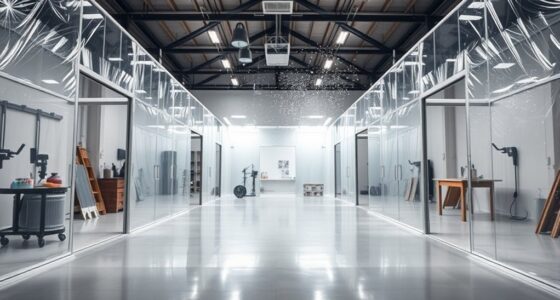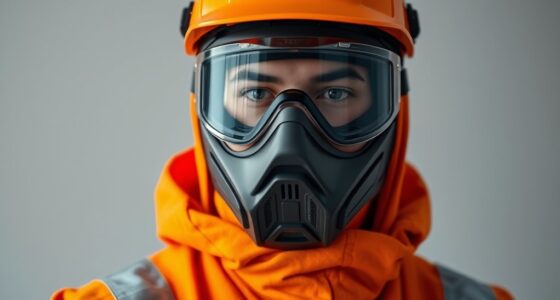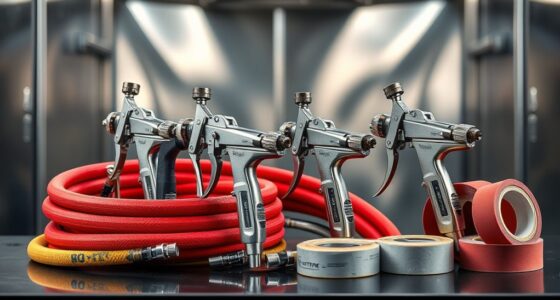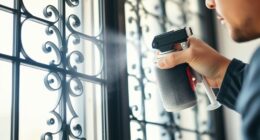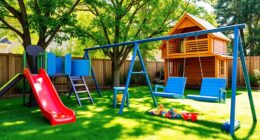To choose the right paint sprayer, consider your project type: for furniture, you need a sprayer with adjustable settings, smaller nozzles, and the ability to handle thinner paints for detailed work. For walls, opt for a sprayer with larger nozzles and higher capacity to cover broad surfaces efficiently. Matching your sprayer to the paint viscosity and surface will improve results. Keep exploring to discover how to select the perfect tool for every job.
Key Takeaways
- Select sprayers with adjustable settings for furniture’s detailed, intricate surfaces versus larger, fast coverage needs of walls.
- Use smaller nozzles for furniture to achieve smooth, precise finishes; larger nozzles suit walls for efficient broad coverage.
- Ensure the sprayer can handle different paint viscosities, with thinner paints for furniture and thicker for walls.
- Prioritize models with pressure control for consistent application and avoiding drips or uneven coats on both surfaces.
- Choose high-capacity, versatile sprayers for walls to cover large areas quickly, while detail-oriented tools are better for furniture projects.
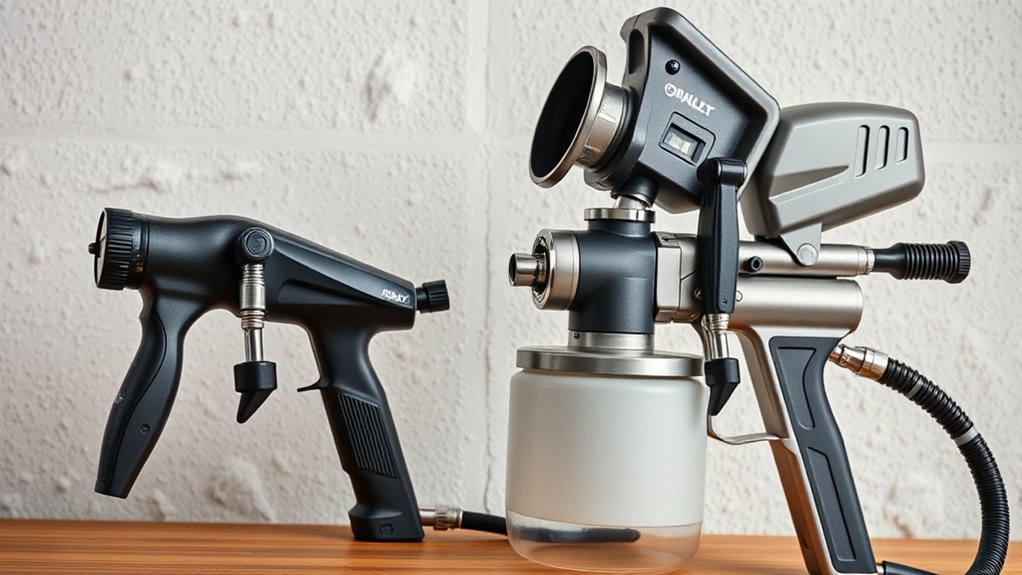
Are you overwhelmed by the variety of paint sprayers available and unsure which one suits your project best? It’s common to feel this way, especially when choosing between different tools for furniture and walls. The key is understanding that not all paint sprayers are created equal, and selecting the right one depends on the specific job at hand. One of the most important factors to weigh is how the sprayer handles different brush types and paint viscosity. These elements directly impact the quality of your finish and ease of use, so it’s worth paying close attention.
When spraying furniture, you want a sprayer that offers precision and control. Furniture projects typically involve smaller, intricate surfaces, so a sprayer with adjustable settings is ideal. Look for one that can handle thinner paints and stains, which often have lower viscosity. This ensures smooth, even coverage without drips or runs. A detail-oriented sprayer with a smaller nozzle allows you to navigate tight corners and delicate surfaces easily. Regarding brush types, some sprayers use different nozzle or tip options, which can influence the spray pattern and finish. Choosing the right nozzle size helps you achieve a fine, smooth coating that enhances the furniture’s appearance. You’ll want a sprayer that can adapt to various paint viscosities, so you can work with both thick paints and thin finishes without clogging or uneven spray. Additionally, pressure adjustment is crucial for controlling the flow and ensuring a flawless look on detailed pieces.
For walls, however, the priority shifts toward efficiency and covering large areas quickly. Wall projects usually involve thicker paints, like latex or primer, which require a sprayer capable of handling higher viscosity. Look for a sprayer with a robust motor and larger nozzle or multiple spray patterns to maximize coverage. These sprayers often have adjustable pressure controls, allowing you to balance speed and spray quality. Brush types matter less here, as the focus is on broad, uniform application rather than detail. The ability to spray thicker paints smoothly ensures you get an even coat across expansive surfaces, reducing the need for multiple coats.
Frequently Asked Questions
Can I Use a Wall Paint Sprayer for Furniture Projects?
You can use a wall paint sprayer for furniture projects, but you need to consider sprayer compatibility and your furniture finishing goals. Wall sprayers often have larger nozzles, which might cause uneven coats or drips on furniture surfaces. For smooth finishes, a sprayer with adjustable settings and finer nozzles is better. Check your sprayer’s specifications to ensure it suits furniture finishing to achieve professional-looking results.
What Safety Gear Is Essential When Using a Paint Sprayer?
Imagine you’re refinishing a piece of furniture and accidentally spray paint near your face. To stay safe, you need essential safety gear. Always wear protective gloves to prevent skin contact and a respiratory mask to avoid inhaling fumes or overspray. These items safeguard your health, especially during prolonged projects. Prioritizing safety gear ensures you work confidently and avoid health issues caused by paint chemicals and airborne particles.
How Do I Prevent Drips and Overspray With Furniture Paint Sprayers?
To prevent drips and overspray when using furniture paint sprayers, you should focus on controlling your spray pattern and adjusting for paint viscosity. Keep your spray pattern consistent and slightly narrower for furniture to avoid excess paint buildup. Thinning the paint to the right viscosity helps it flow smoothly, reducing drips. Also, maintain a steady hand and keep the sprayer at the right distance to make certain of even coverage without overspray.
Are There Specific Paint Types Compatible With Different Sprayers?
Did you know that using the right paint type can improve spray efficiency by up to 30%? When considering paint compatibility, check your sprayer’s specifications to guarantee it works with latex, oil-based, or chalk paints. Always clean your sprayer thoroughly after each use to prevent clogs and maintain ideal performance. Choosing compatible paint and proper sprayer cleaning will give you smooth, professional results every time.
How Long Does It Take for Furniture Paint to Dry After Spraying?
The drying time for furniture paint after spraying typically ranges from 1 to 4 hours, depending on the type of paint and environmental conditions. Keep in mind, while the surface may feel dry, full paint curing can take up to 2 weeks. To make certain of the best finish, allow ample drying time and avoid heavy use until the paint has fully cured. Proper drying and curing are essential for durability.
Conclusion
Choosing the right paint sprayer makes all the difference in your project’s success. Remember, using the wrong tool can increase your paint waste by up to 30%, costing you time and money. Whether you’re refinishing furniture or painting walls, selecting the appropriate sprayer guarantees a smooth, professional finish. So, consider your job size and detail needs—your perfect paint job is just a sprayer away, saving you effort and achieving stunning results every time.
Franz came aboard the Paint Sprayer Zone team with a background in both journalism and home renovation. His articulate writing style, combined with a passion for DIY projects, makes him an invaluable asset. Franz has a knack for breaking down technical jargon into easy-to-understand content, ensuring that even the most novice of readers can grasp the complexities of paint sprayers.



